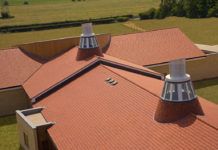 With the introduction of the new British Standard BS 5534 on March 1 and all that it entails with regards to tile, ridge and hip tile fixing, where does this all leave the great old English clay pantile and other similar traditional tiles? Answer; very much alive and well!
With the introduction of the new British Standard BS 5534 on March 1 and all that it entails with regards to tile, ridge and hip tile fixing, where does this all leave the great old English clay pantile and other similar traditional tiles? Answer; very much alive and well!
Firstly, I will summarise the main changes affecting the installation of roof tiles. As of March 1, all tiles on a roof must be mechanically fixed; i.e. nailed, screwed, clipped etc. All ridge and hip tiles must also be mechanically fixed. This can be by nail, screw or clip, but more likely, ridge and hip tiles will be secured using dry fix systems.
Traditionally, most old clay pantiles were not mechanically fixed at all; they were simply hung over the tile battens supported by their nibs. They were often used on buildings such as barns and cow sheds that not only had no underlay, but usually they did not have full walls or had large openings and so were completely open to the elements. As we know, roof tiles are normally protected from the full force of wind loads because internal pressures are minimised due to the ceilings, walls and the underlay. Therefore, this is perhaps testament to how well traditional pantiles actually performed on the roof in terms of both security and weathertightness.
Fast forward to present day and consider how we can install clay pantiles in accordance with the new fixing requirements, taking Wienerberger’s Sandtoft clay pantiles as an example. Firstly, these are manufactured with nail holes that penetrate through the tile nib, thus enabling every tile to be nailed into the top of the tile battens. Until quite recently though, clipping pantiles in the same way that single lap concrete tiles are clipped – with a clip securing the left hand side of each tile – was difficult if not impossible. This is because this method of clipping the tile tended to cause it to roll over rather than secure it. Therefore, special clips have been developed that sit between the mitred corners of a tile and the adjacent tile in the course below and simultaneously hook and secure both tiles at once – thus preventing the tendency of the tiles to roll over. These clips are very secure and are not visible on the finished roof.
Appropriate appearance
Although we all know and understand the great benefits of dry fixed ridge and hip systems, we must acknowledge that these are not always appropriate for some traditional roofing situations; clay pantiling being a good example. It is certainly possible to use dry fix systems with clay pantiles, but the appearance may not be too pleasing; for example, because pantiles generally have quite deep and sweeping rolls and pans, using a standard dry fix ridge roll means that there are large gaps between the tile pans and the ridge tiles. The nature of clay pantile manufacture means that there are small but natural variations in size between tiles, making it difficult to produce dry fix systems that accurately fill the spaces between tiles and ridge tiles.
Therefore, for most traditional clay pantile roofs, the only solution is to continue bedding clay ridge tiles on mortar. To ensure this can be done in compliance with BS 5534, Sandtoft has developed a simple mortared ridge fixing kit. This comprises straps to secure a timber batten at the ridge or hip, and screws with plates and washers to secure the ridge or hip tiles. This means ridge and hip tiles can have the traditional mortared appearance whilst being fully mechanically secured.
Of course, there are also some great modern alternatives to traditional clay




